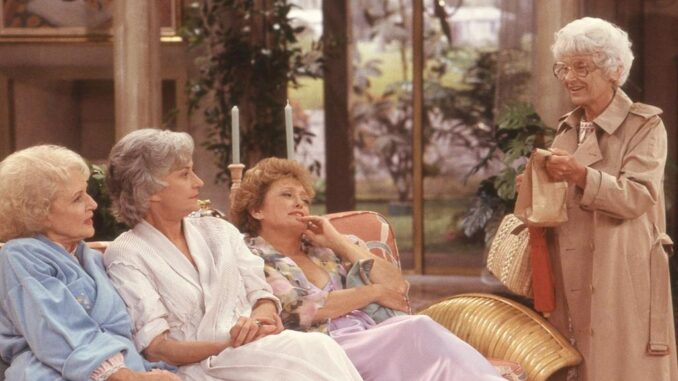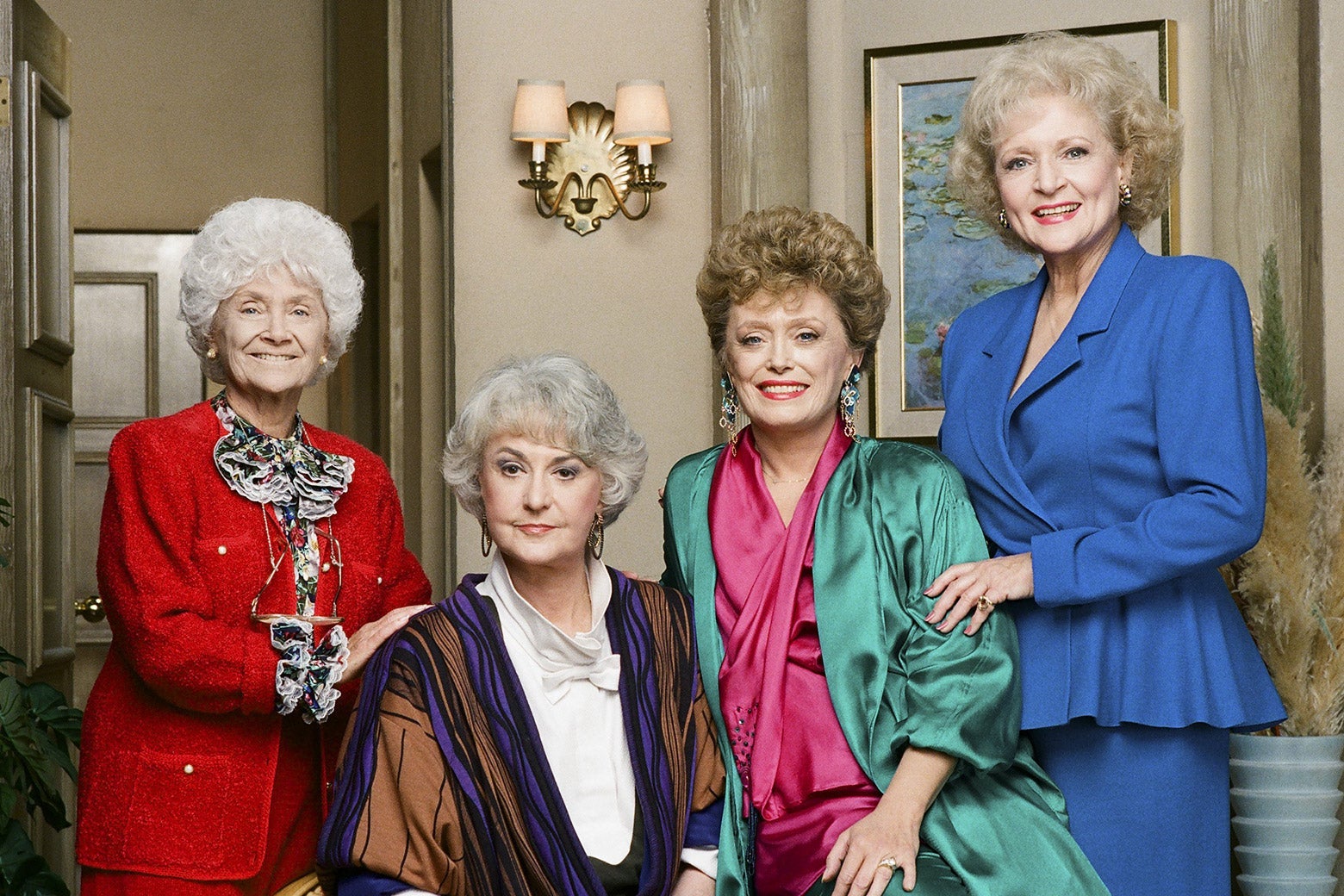

As if presiding over a festive wake, both the Hallmark Channel and WE tv are airing Golden Girls marathons this week. This heavy-rotation tribute to the show’s top-billed star, Beatrice Arthur, provides die-hard fans with a low-key alternative to rending their garments. Additionally, it provides us all with a fine opportunity to assess the sitcom anew. We begin with the observation that The Golden Girls is way too good for WE, where it rubs its ‘80s shoulder pads with Amazing Wedding Cakes and Women Behind Bars.
The show debuted in September of 1985, a time that, in TV terms, is as distant as the Enlightenment. The Golden Girls joined an NBC lineup that featured The A-Team, Remington Steele, Hill Street Blues, St. Elsewhere, Miami Vice, The Cosby Show, and Cheers. To be sure, there was room for raw idiocy on the schedule of programming executive Brandon Tartikoff. TV Bloopers & Practical Jokes aired on Mondays at 8 p.m., thus anticipating the current strategy of programming executive Ben Silverman: Howie Mandel’s Candid Camera knockoff does the practical jokes while his thought process behind greenlighting dreck like Crusoe covers the blooper angle. Those were different times, and The Golden Girls aired during a two-hour block of Saturday-night comedies. Yes, children, people used to watch network TV on Saturdays, instead of going to meth parties or diddling their Twitters or whatever passes for an evening’s entertainment nowadays.
It aired at 9 p.m., between 227 and The Facts of Life, two other gynocentric comedies, the one celebrating the role of women in holding communities together, the other inculcating a fetish for prep-school girls. But The Golden Girls—about a group of older women sharing a Miami house designed like a multichamber sunroom—trafficked in something like pop feminism, and it’s terrifically apt that Arthur played the Carrie Bradshaw figure in a sketch deftly spoofing on Sex and the City.
Created by Susan Harris—a pioneering producer and the writer of the famous abortion episode of Arthur’s Maude—Golden Girls boasted characters who were sharp in their humor and secure in their freedoms, which included the freedom to be mean. The show’s most biting laugh lines—which are shaped so well that these scripts would work for radio—achieve that ideal bitchiness animating The Women. In a typical moment, Blanche, the vain Southern belle played by Rue McClanahan, preens, “One thing I know for sure, I have not lost my hourglass figure.” Which is the cue for Arthur, as acid Dorothy, to snipe, “And it looks like somebody poured about 90 minutes of extra sand in the glass.” The in-studio audience laughs, and Blanche laughs it off. That the characters insult one another so viciously indicates their intimacy. When addressing the comforts and frustrations of friendship, The Golden Girls is more interesting than Friends (which had its moments) and as compelling as I Love You, Man (which has some rather awesome moments). Call it The Sisterhood of the Comfortable Slacks.
Let us review the girls’ bios, as if you need reminding: Blanche Devereaux was the youngest and most sexually ambitious, occasionally catching the vapors, sometimes mincing rhythmically. Blanche vamps along as a cartoon version of a Tennessee Williams hothouse flower, with her first name swiped from A Streetcar Named Desire and her regular references to her father as “Big Daddy” nodding to Cat on a Hot Tin Roof. But McClanahan brings the part to life by coming on like a light-farcical version of Maxine Faulk, the rapaciously lusty widow played by Ava Gardner in the underappreciated film version of The Night of the Iguana.
Betty White played Rose Nylund, who had relocated to Miami from St. Olaf, Minn., where all children are subnormal, based on the evidence of her cracked anecdotes and gloriously dingbatty self. The Golden Girls is a broad ethnic comedy, and she is its Norwegian-American emissary of the upper Midwest, as affable as Marge Gunderson’s accent, though without any brains. Not just the daffiest of the girls, Rose is also the prettiest, and the combination gives her an aspect of Elsie the Cow.
Estelle Getty was Sophia Petrillo, the mother of Arthur’s Dorothy. From Sicily by way of Brooklyn, she slices off her lines like Catherine Scorsese in her bit part in Goodfellas. Because The Golden Girls made the scene before the political correctness and identity politics of the 1990s, its writers didn’t get hung up on inappropriate jokes, and Sophia, because of her advanced age and old-world attitude, was given the most tasteless. In a fairly tame instance, she wonders, of a girl-on-girl hug, “What is this, Wimbledon?”
Which brings us to Dorothy Zbornak, who, despite having been raised by Sophia, speaks in the Catskills cracks and vaudeville cadences of Jewish humor. Either Dorothy is intended as a generically ethnic New Yorker or else she picked this up during her decades of marriage to ex-husband Stanley. Significantly, while the other three girls are widows, Dorothy is a divorcee. Her lines are the most bitter and world-weary. She exudes the strongest scent of desperation about dying alone.
Wrapping up the first night of its Golden Girls marathon on Monday, WE aired the series finale, the second half of a two-parter titled “One Flew Out of the Cuckoo’s Nest.” For a valediction, The Golden Girls married Dorothy off to an eligible bachelor played by Leslie Nielsen. In her angular white wedding dress, she looked like a hybrid of Ivana Trump, Krystle Carrington, Cruella DeVille, and a snowy egret. The episode ends with a group hug and then an encore of the hug. What was this, the LPGA tour? Then Dorothy disappears into the sunset, perhaps the one from the first scenes of the opening credits, with a jet sliding in front of an orange disc like a friendly vision of the great grand finale in the sky.
